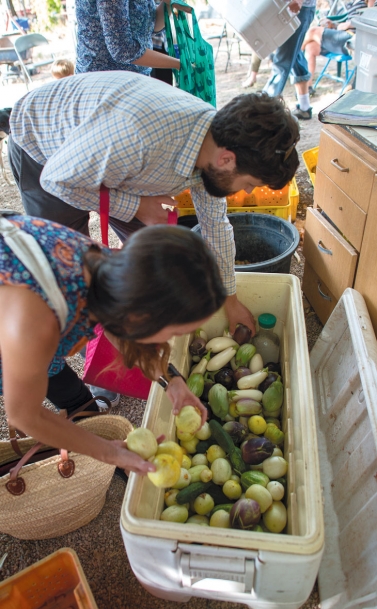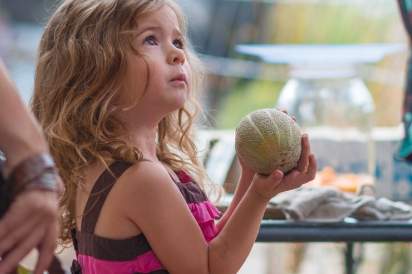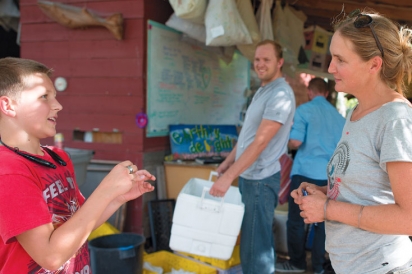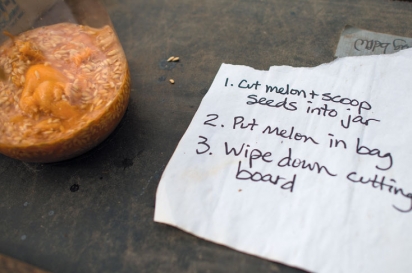CSA Culture: A Week-by-Week Adventure
Our collective lack of an American “food culture” is a woe articulated by many a food-focused philosopher. In her book Animal, Vegetable, Miracle, Barbara Kingsolver describes it this way: “Food cultures concentrate a population’s collective wisdom about the plants and animals that grow in a place, and the complex ways of rendering them tasty. Living without such a culture would seem dangerous. And here we are, sure enough in trouble...”
I’ll spare you the rest, where she delves into our national obesity epidemic, diet-related health problems and fad diets that constitute a culture of “anti-eating.” We’ve heard it all before, lived it all before. Still each year, I see the community-supported agriculture (CSA) harvest subscription model becoming more solidly anchored at the center of a burgeoning food culture—at least for CSA members.
CSA pickups at our farm have become a place of camaraderie and intrigue, where folks from different walks of life find common ground around food produced a few hundred feet from where they’re standing, harvested a few hours before they arrive. Each week, they come to the pickup after a day of working or not, dressed in business suits or swimsuits, with kids or beers in tow, sometimes both.
They stay for a few minutes or an hour, sitting in the shade on lawn chairs or on the coolers that hold their week’s goodies, and chat about everything from what they ate for dinner last week to the death of a loved one. And when it’s time to get their produce and head for home, they ooh and ahh appropriately as they see each item they’re getting that week. Together we celebrate each enormous bouquet of brightly colored chard or enticingly plump early turnips, and we count our blessings that we’re able to eat so well, through the work of passionate humans attempting to orchestrate the natural world into something tasty.
It’s common knowledge that I didn’t know beans about food when I first joined a CSA years ago, and I had a painful go of learning how to cook and eat the things in my share—most of which I’d never seen before and was thoroughly terrified (and actually disgusted) to eat. Kale, mustard greens, chard—all of it scared the crap out of me. When I see that deer-in-headlights look on a new member’s face as I’m handing her a gigantic bouquet of collard greens, a more seasoned member will step in.
“I love those in soups!”
“I scramble them with my eggs in the morning, with a little French tarragon.”
You can see her relax as she realizes she’s supported in this frankly huge new endeavor.
And it is truly huge. For so many reasons. Bringing home 18 weeks of vastly more vegetables than you’re used to cramming into your diet, especially when many are unfamiliar and most need to be prepared in some way, is a serious undertaking.
Over seasons, it becomes huge in other ways. A CSA teaches us what can be produced in our valley every week over many months. It also teaches us what isn’t available every week—or, in some cases, ever. But instead of being a letdown, the progression of CSA crops becomes a cultural journey, and each plant brings with its arrival the promise of new, exciting meals that families come to cherish.
When the first green beans arrive in the shares, members squeal about green bean tacos, a phenomenon largely unknown in the mainstream food culture but an almost cultish part of our CSA food culture. (You simply MUST try them if you haven’t already—loads of cumin is the secret.) Sage butter, kale salad with soba noodles, and Casey’s Tasty Leek and Ground Cherry Pizza are all local CSA member favorites, and each year a new member brings another epic dish into the fold. Last year it was caponata from Amanda; the year before, curried pickles from Kailie. The kids move through their delighted season from turnips to peas to ground cherries to watermelons—all the sweetest treats in the shares, and they eat them all like candy during the pickup.
“She never eats vegetables!” a parent will say as his kid is chomping down on a lemon cucumber straight from the cooler.
And if that isn’t the cornerstone of a food culture—elders teaching healthy eating habits to the next generation—what is?
“These are the mores of survival,” Kingsolver writes: “good health, and control of excess. Living without them would seem dangerous.” But living with them is supremely delicious—a delectable, satisfying, season-by-season adventure.
If you’re interested in joining a CSA, the winter is the time to do it. That’s when farmers offer shares for the coming season. Check out edibleidaho.com for information.
Casey O’Leary runs Earthly Delights Farm, an urban CSA and seed farm in Boise, and manages the Snake River Seed Cooperative, working with regional farmers to create a resilient regional seedshed.









